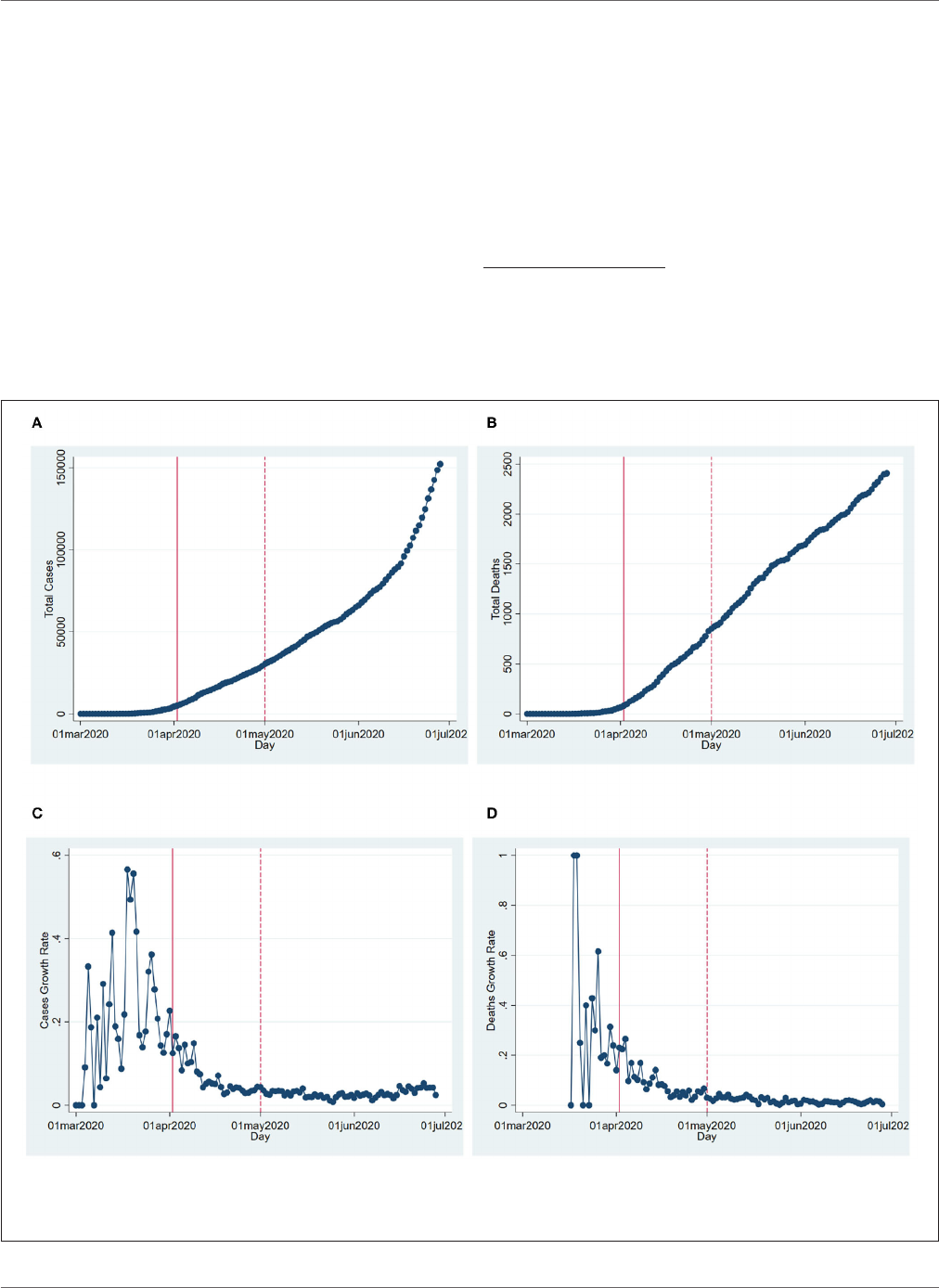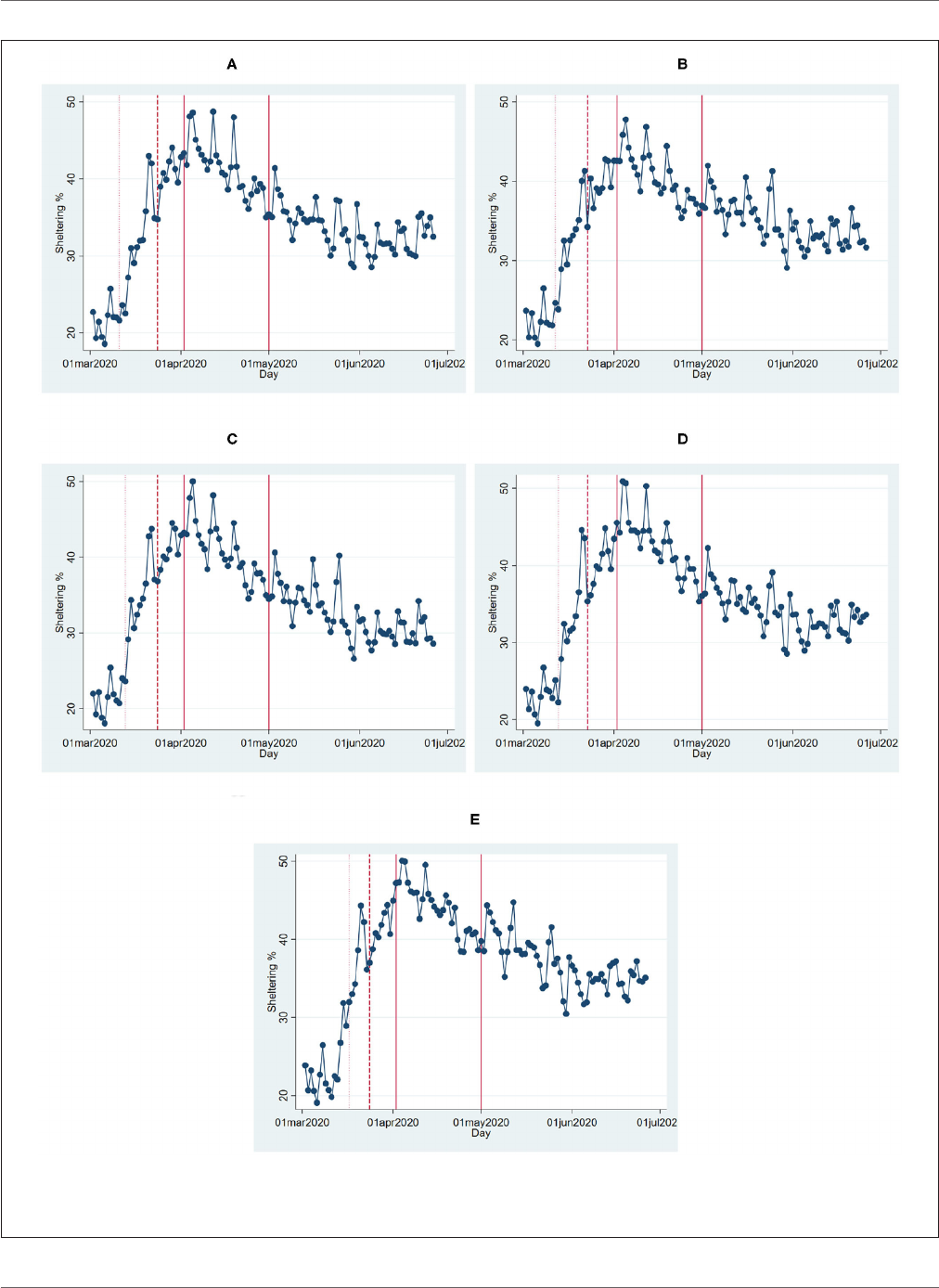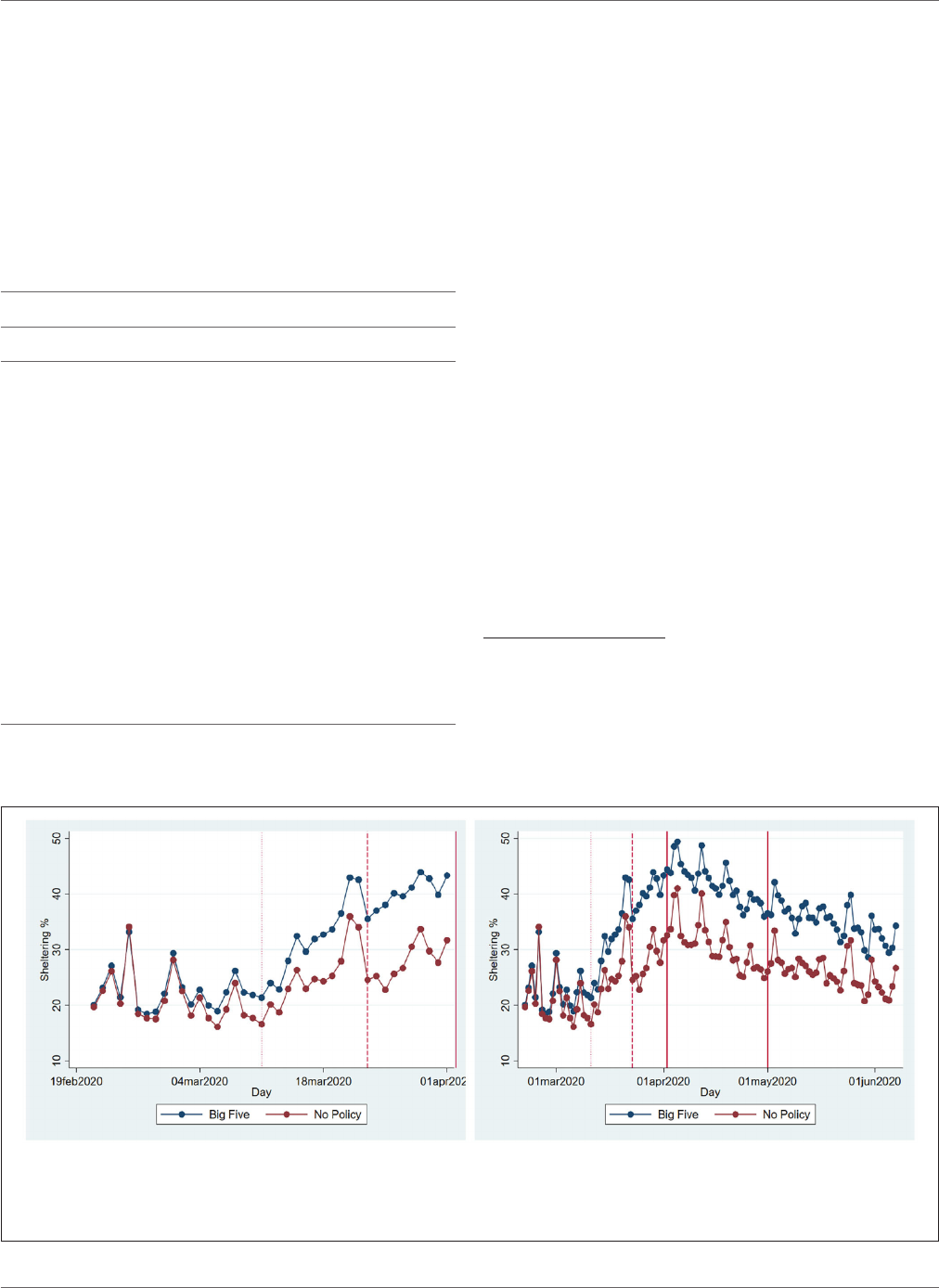
University of Texas at Tyler University of Texas at Tyler
Scholar Works at UT Tyler Scholar Works at UT Tyler
Economics Faculty Publications and
Presentations
Social Sciences
11-2020
The Effect of Shelter-in-Place Orders on Social Distancing and the The Effect of Shelter-in-Place Orders on Social Distancing and the
Spread of the COVID-19 Pandemic: A Study of Texas Spread of the COVID-19 Pandemic: A Study of Texas
Marco A. Castaneda
University of Texas at Tyler
, mcastaneda@uttyler.edu
Meryem Saygili
University of Texas at Tyler
, msaygili@uttyler.edu
Follow this and additional works at: https://scholarworks.uttyler.edu/econ_fac
Part of the Social and Behavioral Sciences Commons
Recommended Citation Recommended Citation
Castaneda, Marco A. and Saygili, Meryem, "The Effect of Shelter-in-Place Orders on Social Distancing and
the Spread of the COVID-19 Pandemic: A Study of Texas" (2020).
Economics Faculty Publications and
Presentations.
Paper 1.
http://hdl.handle.net/10950/2802
This Article is brought to you for free and open access by the Social Sciences at Scholar Works at UT Tyler. It has
been accepted for inclusion in Economics Faculty Publications and Presentations by an authorized administrator of
Scholar Works at UT Tyler. For more information, please contact tgullings@uttyler.edu.

ORIGINAL RESEARCH
published: 26 November 2020
doi: 10.3389/fpubh.2020.596607
Frontiers in Public Health | www.frontiersin.org 1 November 2020 | Volume 8 | Article 596607
Edited by:
Nemanja Rancic,
Military Medical Academy, Serbia
Reviewed by:
Cheng-Fang Yen,
Kaohsiung Medical University, Taiwan
Yuriy Timofeyev,
National Research University Higher
School of Economics, Russia
*Correspondence:
Meryem Saygili
Specialty section:
This article was submitted to
Health Economics,
a section of the journal
Frontiers in Public Health
Received: 27 August 2020
Accepted: 05 November 2020
Published: 26 November 2020
Citation:
Castaneda MA and Saygili M (2020)
The Effect of Shelter-in-Place Orders
on Social Distancing and the Spread
of the COVID-19 Pandemic: A Study
of Texas.
Front. Public Health 8:596607.
doi: 10.3389/fpubh.2020.596607
The Effect of Shelter-in-Place Orders
on Social Distancing and the Spread
of the COVID-19 Pandemic: A Study
of Texas
Marco A. Castaneda and Meryem Saygili
*
Department of Social Sciences, University of Texas at Tyler, Tyler, TX, United States
Objectives: We study how the state-wide shelter-in-place order affected social
distancing and the number of cases and deaths in Texas.
Methods: We use daily data at the county level. The COVID-19 cases and fatalities data
are from the New York Times. Social distancing measures are from SafeGraph. Both data
are retrieved from the Unfolded Studio website. The county-level COVID-related policy
responses are from the National Association of Counties. We use an event-study design
and regression analysis to estimate the effect of the state-wide shelter-in-pla ce order on
social distancing and the number of cases and deaths.
Results: We find that the growth rate of cases and deaths is significantly lower during the
policy period when the percentage of the population that stays at home is highest. The
crucial question is whether the policy has a causal impact on the sheltering percentages.
The fact that some counties in Texas adopted local re strict ive policies well before the
state-wide policy helps us address this question. We do not find evidence that this
top-down restrictive policy increased the percentage of the population that exercised
social distancing.
Discussion: Shelter-in-place policies are more effective at the local level and should go
along with efforts to inform and update the public about the potential consequences of
the disease and its current state in their localities.
Keywords: COVID-19, shelter in place, social distancing, public health, pandemic (COVID-19)
1. INTRODUCTION
The global pandemic of COVID-19 affected countries and communities around the globe with
detrimental impacts on population health as well as economies. The tragic examples from
countries such as Italy and Spain showed the importance of flatting t h e curve as sudden surges in
hospitalization can easily strain even the well-functioning healt hcare systems (
1, 2 ). COVID-19 is
thought to spread mainly through close contact from person-to-person
1
. Therefore, policy makers
tried to control the spread of the disease and reduce the burden on the healthcare system by policies
1
Centers for Disease Control and Prevention, (CDC) : https://www.cdc.gov/coronavirus/201 9-ncov/faq.html#Spread.

Castaneda and Saygili State-Wide Shelter-in-Place Order and Social Distancing in Texas
that encourage and sometimes force social distancing
2
. In the
United States, the state-wide shelter-in-place policies are the most
common of such policies. Shelter-in-place orders (SIPO) require
residents to remain home for all but essential activities such
as purchasing food or medicine, caring for others, exercise, or
traveling for employment deemed essential. Between March 19
and April 20, 2020, 40 states and the District of Columbia adopted
SIPOs (
3).
A fast-growing body of literature explores the potential
impacts of stay-at-home orders on various indicators from
the COVID-19 hospitalizations, cases, and fatalities to their
implications for mental health (4, 5), physical he a lth (6, 7), and
domestic violence (8–10). Some studies find that stay-at-home
orders are associated with a slower growth rate of hospitalization
(11, 12). Closer to our study are the ones t hat focus on COVID
cases and deaths. (13) analyzes the US data from March 1 , 2020,
to April 27, 2020, and find that adoption of government-imposed
social distancing measures reduced the da ily growth rate by 5.4
percentage points after 1–5 days, 6.8 after 6–10 days, 8.2 after
11–15 days, and 9.1 after 16–20 days. Similarly, (
3) work with
data from all the states from March 8, 2020, to April 17, 2020.
Using daily state-level social distancing data from SafeGraph and
a difference-in-differences approach, they find that adoption of a
shelter-in-place order (SIPO) is associated with a 5–10% increase
in the rate at which state residents remained in their homes full-
time. Also, using daily state-lev el coronavirus case data collected
by the CDC, th ey find that approximately 3 weeks following the
adoption of a SIPO, cumulative COVID-19 cases fell by 44%.
Similar to our paper, (14) focus on a particular state, namely
California, to estimate the impact of the state-wide SIPO on the
COVID-19 cases and deaths.
We focus on a large state, Texas. Our data span almost
4 months, which allows us to see better the evolution of the
pandemic during as well as after the expiry of the SIPO. The
fact that Texas is one of the relatively early states to start t h e
reopening and experiences a post-opening surge in t he number
of cases makes it an interesting case to study closely. We use daily
data from March 1, 2020 to June 27, 2020, to study t h e evolution
of the COVID-19 pandemic in 254 Texas counties. We analyze
the impact of the statewide shelter-in-place order issued on April
2, 2020, on the measures of social distancing, and consequently,
on t h e COVID-19 cases and dea ths.
2. MATERIALS AND METHODS
2.1. Data
The data for this study comes from the Unfolded Studio website
(https://covid19.unfolded.ai/). The website compiles data from
various sources. The COVI D-19 cases and fatalities data are
from the New York Times
3
. Social distancing measures are
2
Social distancing, also called “physical distancing” is defined by the CDC as
keeping a safe space (at le ast 6 feet) between yourself and other people who are
not from your household.
3
The data are consistent with the count of cases and fatalities from the CDC and
John Hopkins University.
from SafeGraph
4
. County-level population data are from the US
Census. SafeGraph’s social distancing data are generated using a
panel of GPS pings from anonymous mobile devices. The data
determine the common nighttime locat ion of each device and
call that location “home” (approximately a 153 by 153 m area).
The shelter-in-place percentage reported in the Unfolded data
shows the percentage of the population who stayed at home on a
day. Finally, we use the National Association of Counties’ (NACo)
county explorer to get county-level COVID 19 related policy
responses. Our dataset is daily and at the county level.
2.2. Methods
2.2.1. Theoretical Background
We provide a basic description of the theoretical foundations for
the spread of the disease. Although the model of a pandemic
is not strictly exponential, the exponential growth model may
provide a good approximation at the beginning of the pandemic
and is implicitly used in much of the literature.
The discrete-time version of the exponential growth model is
described by the equation
5
:
c
t
= c
0
(1 + δ)
t
(1)
where c
t
denotes the total number of cases at time t, δ represents
the growth rate, and c
0
is the number of cases at time z ero.
The parameter of interest is δ, the rate of growth of the process,
which can be interpreted as the number of infected individuals
by one infected individual in a day. Rearranging Equation (1), we
can write
c
t+1
− c
t
c
t
= δ . (2)
Given a sample
{
c
t
}
of observations, we are interested in
estimating the growth rate and the effect of a policy variable (T
t
)
on t he growth rate. This can be done by estimating the equation
y
t
= β
1
+ α
1
T
t
+ u
t
(3)
where
y
t
=
c
t+1
− c
t
c
t
(4)
where y
t
is the growth rate, β
1
is the estimated growth rate before
the policy, and β
1
+α
1
represents the growth rate after the policy,
with α
1
being t he effect of the policy.
The model we present provides a good approximation for
the evolution of the number of cases. Fatalities, however, are
much harder to model. Similar to cases, we analyze the growth
rate of deaths to provide a complete picture. However, we are
aware of the problems associated with fitting the same type of
model for cases and fatalities. First, social distancing may have
different effects on the growth of cases and deaths. In particular,
social distancing measures are more likely to show a bigger and
4
Several studies rely on SafeGraph for social distancing measures. See (
3, 14–17)
among many others.
5
The continuous-time version yields similar conclusions. We stick to the discrete
version for expositional simplicity.
Frontiers in Public Health | www.frontiersin.org 2 November 2020 | Volume 8 | Article 596607

Castaneda and Saygili State-Wide Shelter-in-Place Order and Social Distancing in Texas
faster impact on the spread of the disease than the number (or
growth rate) of fatalities. In addition, as medical researchers learn
more about the disease, they will be able to reduce fatality rates,
presumably, long before they find a definitive cure to completely
eradicate it. Even though the disease keeps spreading, we may
see lower rates of f atalities. This may even happen without any
outside intervention if the virus evolves and becomes less fatal.
The analysis of the effects of the shelter-in-place order on
social distancing and the number of cases and deaths was
conducted at the state level and at the county level.
2.2.2. State-Level Analysis
For the state-level analysis, we aggregated the county data by
summing up the daily values for all counties to get the state-level
time series data. To estimate the effects of the SIPO, we divide the
SIPO period into 4 weekly subperiods since we expect the SIPO
to have a gradual impact on the spread of disease
6
. We estimate
the following empirical model:
y
t
= β
0
+α
0
SIPO
0
+α
1
SIPO
1
+α
2
SIPO
2
+α
3
SIPO
3
+θ
1
Day+u
t
(5)
where y
t
is either the growth rate of cases and fatalit ies, or
the measure of social distancing. SIPO
0
is the week the order
was enacted, SIPO
1
is the second, SIPO
2
is the third week, and
SIPO
3
is the fourth and the last week that t h e policy was in
6
According to the World Health Organization, the incubation period for
COVID-19, which is the time between exposure to the virus (becoming
infected) and symptom onset, is on average 5–6 days, however, can be
up to 14 days: https://www.who.int/docs/default-source/coronaviruse/situation-
reports/20200402-sitrep-73-covid-19.pdf?sfvrsn=5ae25bc7_6#:~:text=.
FIGURE 1 | COVID-19 cases and fatalities in Texas. (A) Cumulative cases. (B) Cumulative fatalities. (C) Daily cases growth. (D) Daily fatalities growth. This figure
shows the cumulative cases and fatalities, as well as their growth rates over the time in Texas. The solid and dashed vertical lines show the beginning (April 2, 2020)
and the end of the state-wide shelter-in-place order (May 1, 2020).
Frontiers in Public Health | www.frontiersin.org 3 November 2020 | Volume 8 | Article 596607

Castaneda and Saygili State-Wide Shelter-in-Place Order and Social Distancing in Texas
effect. The model also includes a linear daily time trend. In
addition, we estimate the effects of the SIPO on the growth rate of
cases and fatalities controlling for social distancing to determine
whether the policy had any effects other than its effect through
social distancing.
2.2.3. County-Level Analysis
The state-level analysis indicates that the SIPO reduced the
spread of the disease through its effe ct on social distancing (the
percentage of the population sheltering in place). Therefore, we
use the county-level analysis to further investigate the effect of
the statewide SIPO on social distancing, while controlling for
local policies.
First, we investigate th e effect of the statewide SIPO on the
larger counties which implemented local policies before the
statewide SIPO (Harris, Dallas, Tarrant, Bexar, or Travis). In each
of these counties, first, a public health emergency is declared,
which is then followed by a local stay-at-home order, and t hi s
is later followed by the state-wide shelter-in-place order. We
assume each policy replaces the former. For the analysis, we
estimated the following equation:
y
i,t
= β
0
+ α
0
SIPO
0
+ α
1
SIPO
1
+ α
2
SIPO
2
+ α
3
SIPO
3
+ β
1
X
i,t
+ θ
1
Day + u
it
(6)
where y
i,t
is the sheltering percentages in county i on day t and
X
i,t
includes the county-level policies (local emergency or local
shelter-in-place order). In addition, we control for a daily time
trend and county fixed effects. The regressions are weighted by
county-population and the standard errors are clustered at the
county-level.
Next, we investigate the effect of the statewide SIPO on the
counties that never had any type of local county-level policy. If
the statewide SIPO is effective in increasing the percentage of the
population that stays at home, one would expect counties without
any restrictive local policies to catch up with other counties
once the state-wide blanket policy is imposed. Therefore, we
estimated the following equation including all the counties in
the state:
y
i,t
= β
0
+ α
0
SIPO
0
+ α
1
SIPO
1
+ α
2
SIPO
2
+ α
3
SIPO
3
+
α
4
SIPO
0
∗
NoPolicy + α
5
SIPO
1
∗
NoPolicy + α
6
SIPO
2
∗
NoPolicy+
α
7
SIPO
3
∗
NoPolicy + Day
t
+ u
i,t
(7)
where y
i,t
is the sheltering percentages in county i on day t. The
key variable, NoPolicy, i s a dummy that takes the value of one if
the county did not have any local policy prior to the statewide
SIPO. We include day and county fixed-effects. The regressions
are weighted by county population and the standard errors are
clustered at the county-level.
3. RESULTS
3.1. State-Level Results
Figure 1 shows the total cases and fat alit ies by day in Texas as
well as the growth rates of those. We estimate Equation (5) for
TABLE 1 | The growth of COVID-19 cases and fatalities.
Cases Fatalities
SIPO
0
−0.035 −0.067
(0.023) (0.061)
SIPO
1
−0.070*** −0.105**
(0.022) (0.051)
SIPO
2
−0.084*** −0.131***
(0.016) (0.043)
SIPO
3
−0.074*** −0.108***
(0.013) (0.036)
Day −0.002*** −0.004***
(0.000) (0.001)
Observations 117 102
Adjusted R
2
0.390 0.368
***,**Indicate significance at 1% and 5%, respectively. Robust standard errors are reported
in parentheses.
the growth rate of cases and fatalities. The results in Table 1
show that the growth rates of cases are 0.07–0 .084 points lower
during the SIPO period. Given that the mean growth rate of
cases is about 0.1 outside the period, these numbers imply large
drops in the growth rates of cases during the period. Similarly,
the growth rate of deaths is 0.105–0.131 points lower during
the SIPO, t he largest decreases happening in the third week of
the policy.
We also analyze the impact of the policy on social distancing
measures. In particular, we look at the percentage of population
sheltering in place cre ated by SafeGraph. Figure 2 shows the
percentage of the population that shelters in place. Table 2
reports t h e regression results we get from estimating Equation
(5) for the sheltering percentages
7
. Both the table and figure
indicate the percentage of the population that shelters in
place is, on average, higher during the SIPO period. The
highest rate of sheltering corresponds to the first week of
the SIPO, and the sheltering percentage gradually goes down
even when the SIPO was still in effect. Compared to the
sheltering percentage outside the policy period (25%), the share
of sheltering population is about 9–41% higher during the
SIPO period.
Table 3 shows the impact of t he SIPO on the growth of
cases and fatalities when we control for lagged sheltering
percentages. Because of t he nature of the disease, social
distancing measures show impact only after a while. We estimate
Equation (5) using the 14-day lagged sheltering percentages in
addition to the SIPO indicators and time trends
8
. The table
reveals t hat the SIPO dummies are statistically insignificant
once the sheltering population is controlled for. These results
suggest the SIPO may slow down the spread of the disease
7
Weather conditions also affect the sheltering percentages. More people are likely
to stay at home during rainy or cold days than on sunny days. However, we are
mainly interested in t he effect of the SIPO on sheltering. As long as the weather
is not correlated with the enactment of the policy, our estimates would still be
unbiased (
18).
8
The fit of the regression (R
2
) is largest with 13–15 days lags, and we use 14 days.
Frontiers in Public Health | www.frontiersin.org 4 November 2020 | Volume 8 | Article 596607

Castaneda and Saygili State-Wide Shelter-in-Place Order and Social Distancing in Texas
FIGURE 2 | Sheltering population. (A) Sheltering %. (B) Sheltering % weighted by population. This figure shows the average percentage of the population that stays
at home in Texas over time. The solid and dashed vertical lines show the beginning (April 2, 2020) and the end of the statewide shelter-in-place order (May 1, 2020).
For the right panel, the counties’ sheltering percentages are weighted by the counties’ populations, and then aggregated at the state level.
TABLE 2 | Sheltering population and the SIPO.
Sheltering %
SIPO
0
10.443***
(1.591)
SIPO
1
8.584***
(1.411)
SIPO
2
5.870***
(1.067)
SIPO
3
2.287***
(0.784)
Day 0.010
(0.013)
Observations 118
Adjusted R
2
0.400
***, **Indicate significance at 1% and 5%, respectively. Robust standard errors are reported
in parentheses.
through its effect on the percent age of people sheltering in
place. The policy itself is not significa nt once we control for
this percentage.
The state-level analysis shows one thing is clear: Social
distancing slows down the growth of cases
9
. The important
question remaining is whether the state-wide SIPO had a causal
impact on social dist ancing as measured by shelter-in-place
percentages. We address this question in th e next section.
3.2. County-Level Results
Figure 2 shows that the shelter-in-place percentages started
to increase well before t h e state-level SIPO order. According
to NACo, many counties adopted local policies such as
9
The Appendix shows we get similar results with county-level panel data.
TABLE 3 | The growth rates controlling for lagged sheltering percentages.
Cases Fatalities
SIPO
0
0.017 −0.018
(0.025) (0.051)
SIPO
1
−0.006 −0.043
(0.020) (0.033)
SIPO
2
0.020 −0.025
(0.027) (0.026)
SIPO
3
0.006 −0.027
(0.021) (0.021)
Lagged sheltering −0.009*** −0.009**
(0.002) (0.004)
Day −0.002*** −0.003***
(0.000) (0.001)
Observations 118 102
Adjusted R
2
0.442 0.409
***,**Indicate significance at 1% and 5%, respectively. Robust standard errors are reported
in parentheses.
public health emergency and safer-at-home declarations days
or weeks before the state-wide policy. Overall, 70 counties
in Texas have at least one type of policy, emergency or
county-level shelter-in-place order, while 30 have both. The
adoption of these policies is unlikely to be random. In
particular, the size of the population and the number of
cases are positively correlated with the likelihood of restrictive
policies. This is particularly true for county-level stay-at-home
orders. Several counties declared a health emergency early
on when the cases were few. As the cases went up, the
counties with higher numbers of cases adopted shelter-in-
place orders.
Frontiers in Public Health | www.frontiersin.org 5 November 2020 | Volume 8 | Article 596607

Castaneda and Saygili State-Wide Shelter-in-Place Order and Social Distancing in Texas
FIGURE 3 | Sheltering percentages in Texas counties. (A) Harris. (B) Dallas. (C) Tarrant. (D) Bexar. (E) Travis. This figure shows the percentage of the population that
stays at home in the five most populated counties of Texas over time. The dotted line shows the emergency declaration date, the dashed line shows the county-wide
SIPO, the solid lines mark the beginning and the end of the statewide SIPO.
Frontiers in Public Health | www.frontiersin.org 6 November 2020 | Volume 8 | Article 596607

Castaneda and Saygili State-Wide Shelter-in-Place Order and Social Distancing in Texas
We take a close look at the county-level trends in the most
populated five counties: Harris, Dallas, Tarrant, Bexar, and Travis.
These span the majority of the four biggest cities in Texas:
Houston (Harris), Dallas (Dallas and Tarrant), San Antonio
(Bexar), and Austin (Travis). These five counties make about 44%
of the total Texas population, while t h e remaining 249 counties
make up the rest. Perhaps not surprisingly, the earliest COVID-
19 cases emerged in t hese five counties. And, all of these counties
ordered a county-level stay-at-home policy before the state-wide
TABLE 4 | Sheltering percentages in most-populated Texas counties.
Sheltering % Sheltering % Sheltering %
Emergency 6.439***
(0.765)
County SIPO 10.724*** 12.998***
(0.417) (0.503)
SIPO
0
13.122*** 15.093*** 17.095***
(0.430) (0.442) (0.495)
SIPO
1
10.839*** 12.604*** 14.373***
(0.413) (0.426) (0.467)
SIPO
2
8.690*** 10.250*** 11.787***
(0.414) (0.427) (0.453)
SIPO
3
4.938*** 6.278*** 7.566***
(0.382) (0.396) (0.412)
Day 0.034*** 0.063*** 0.097***
(0.006) (0.006) (0.004)
Observations 585 585 585
Adjusted R
2
0.414 0.590 0.647
***, **Indicate significance at 1% and 5%, respectively. Robust standard errors are reported
in parentheses.
SIPO. They also declared a county-wide emergency even before
the sheltering policies
10
.
Figure 3 shows the percentage of the populations sheltering
in place in each of these counties. Table 4 shows the
results from estimating Equation (6). The results reveal that
the initial pronounced increase in sheltering percentages
corresponds to the declaration of county-wide emergency and
shelter-in-place orders.
Next, we take a look at the counties that never had any type
of county-level policy. Figure 4 shows that there is a significant
difference in terms of sheltering population in the biggest five
counties vs. counties that never adopted any type of policy prior
to the state-wide SIPO. The panel that shows the trends before the
state SIPO revea ls that in both groups of counties, the sheltering
percentage increases over time. However, t he gap widens over
time. Interestingly, even after the implementation of the state
SIPO, the gap persisted. The policy did not disproportionately
affect the counties with no prior policies. Also, the gap carries
on after the SIPO expires. The figure suggests that more people
shelter in highly populated areas. This may still be a reflection of
the fact that the perceived risk of catching t he disease is higher in
those areas, and the impact of fear is strong enough to keep more
people at home.
If the SIPO is effective in increasing t he percentage of the
population that stays at home, one would expect counties without
any restrictive policies to catch up wit h others once the state-wide
blanket policy is imposed. We estimate Equation (7) including
10
Harris county declared public health emergency on March 11, and stay at home
order on March 24, which is 9 days prior to the state-wide policy. Similarly, Dallas
county declared an emergency on March 12 and ordered residents to stay at home
on March 23. Tarrant county’s emergency declaration is on March 13, and the
county-level SIPO date is March 24. Bexar county’s declarations were on March 13
and March 23, respectively. For Travis county, the dates are March 17 and March
24, respectively.
FIGURE 4 | Sheltering percentages. (A) Before SIPO. (B) Whole period. The figure shows the average sheltering percentages in two groups of counties: The most
populated five (Harris, Dallas, Tarrant, Bexar, and Travis) and the counties that never adopted any county-level policy. The dotted line shows the earliest emergency
declaration date among the largest five (March 11, 2020), the dashed line shows the earliest county-wide SIPO (March 23, 2020), the solid lines mark the beginning
and the end of the statewide SIPO.
Frontiers in Public Health | www.frontiersin.org 7 November 2020 | Volume 8 | Article 596607

Castaneda and Saygili State-Wide Shelter-in-Place Order and Social Distancing in Texas
TABLE 5 | Sheltering percentages all Texas counties.
Sheltering % Sheltering % Sheltering %
SIPO
0
18.729*** 19.075*** 20.241***
(0.679) (0.672) (0.644)
SIPO
1
16.474*** 16.798*** 18.017***
(0.687) (0.673) (0.635)
SIPO
2
15.548*** 15.946*** 16.886***
(0.628) (0.612) (0.634)
SIPO
3
10.963*** 11.341*** 12.299***
(0.613) (0.577) (0.550)
SIPO
0
*NoPolicy −1.855*** −8.093***
(0.563) (1.066)
SIPO
1
*NoPolicy −1.736*** −8.257***
(0.542) (1.084)
SIPO
2
*NoPolicy −2.131*** −7.158***
(0.472) (1.010)
SIPO
3
*NoPolicy −2.021*** −7.144***
(0.424) (0.929)
Fixed effects
County Yes Yes Yes
Day Yes Yes Yes
Day-NoPolicy No No Yes
Observations 29,718 29,718 29,718
Adjusted R
2
0.934 0.936 0.945
***,**,*Indicate significance at 1, 5, and 10%, respectively. Robust standard errors are
reported in parentheses.
all of the 254 counties. The results in Table 5 shows that the
sheltering percentage is highest in the first week of the SIPO
and gradually decreases, confirming our earlier results. However,
there is no evidence that the sheltering percentage in the counties
without any prior policy converges to the percentages in the
counties with proactive policies. In contrast, there seems to be
a gap between these groups of counties, which persists during the
policy period.
4. CONCLUSION AND DISCUSSION
We analyze both state and c ounty-level effe ct s of the SIPO on the
growth of cases and deaths. We find t hat growth and death rates
are lower during the SIPO period. We also see that a significantly
larger percentage of the population stays at home during this
period. Thus, it is not surprising to see that the disease slows
down in the period of the SIPO. The more interesting question
is whet h er the SIPO caused stay a t home percentages to increase.
We find two pieces of evidence that goes against such causality.
First, even though the highest sheltering corresponds to the first
week of the SIPO, sheltering percentages steadily declined even
though the policy was in effect (Figures 2, 3). This pattern might
be very much a behavioral response to the emergence and the
initial rapid spread of the disease. The fact that people start to see
cases in their communities may create fear, and people respond
by staying at home. However, as the duration of home stay gets
longer, people might develop fatigue and start moving again.
Second, we make use of the fact that some counties adopted local
“safer at home” policies several days before the state-wide blanket
policy. The sheltering percentages in these counties started to
increase before the state-wide SIPO. However, we see a similar
upward trend, albeit at a slower rate, in counties where there
were no such policies. Also, we do not observe that these groups
of counties converge to a similar sheltering percentage after
the state-wide blanket policy. Instead, the counties without any
policy (less populated counties with slower growt h of cases) have
a lower rate of sheltering than the other counties. There seems to
be a gap in terms of sheltering percentages, and it persists during
as well as after the policy period (Figure 4).
Our analyses show that the growth rate of COVID-19 cases
and deaths decreases when a larger share of the population
exercises social distancing by staying at home. However, we
do not find evidence that the state-wide shelter-in-place order
increased the percentage of the population that stay s at home.
The initial local conditions and county policies may have already
encouraged people to stay at home. It may be a better strategy
to reach out to the population and inform them about the
current state of disease in their localities. On the other hand,
policymakers also need to consider the fact that people may not
be able to stay at home even if they want to if their employers ask
them to get back to work in the absence of such policies. What
we suggest is that imposing restrictive policies alone may not be
enough to guarantee that people will exercise soci al distancing.
Thus, such policies must take local conditions into account and
be accompanied by the effort to inform and educate the public
about the potential consequences of the disease and the situation
in t hei r communities.
Even though the current study has interesting policy
implications, it has limita tions. In particular, the results may not
need to generalize to other states or countries. A similar evolution
of the pandemic and similar policy rules may generate quite
different behavioral responses from the public elsewhere. More
local-level studies may be needed to check the generalizability of
our conclusions.
DATA AVAILABILITY STATEMENT
Publicly available datasets were analyzed in this study. This data
can be found here: https://covid19.unfolded.ai/, https://www.
naco.org/covid19/topic/research- data.
AUTHOR CONTRIBUTIONS
All authors listed have made a substantial, direct and
intellectual contribution to the work, and approved it
for publicati on.
Frontiers in Public Health | www.frontiersin.org 8 November 2020 | Volume 8 | Article 596607

Castaneda and Saygili State-Wide Shelter-in-Place Order and Social Distancing in Texas
REFERENCES
1. Saglietto A, D’Ascenzo F, Zoccai GB, De Ferrari GM. COVID-
19 in Europe: the Italian lesson. Lancet. (2020) 395:P1110–1.
doi: 10.1016/S0140-6736(20)30690-5
2. Yuan J, Li M, Lv G, Lu ZK. Monitoring transmissibility and
mortality of COVID-19 in Europe. Int J Infect Dis. (2020) 95:311–5.
doi: 10.1016/j.ijid.2020.03.050
3. Dave D, Friedson AI, Matsuzawa K, Sabia JJ. When do shelter-in-place orders
fight COVID-19 best? Policy heterogeneity across states and adoption time.
Econ Inq. (2020). doi: 10.1111/ecin.12944. [Epub ahead of print].
4. Killgore WDS, Cloonan SA, Taylor, EC, Dailey NS. Loneliness: a signature
mental health concern in the era of COVID-19. Psychiatry Res. (2020)
290:113117. doi: 10.1016/j.psychres.2020.113117
5. Smith ML, Steinman LE, Casey EA. Combatting social isolation among older
adults in a time of physical distancing: the COVID-19 social connectivity
paradox. Front. Public Health. (2020) 8:403. doi: 10.3389/fpubh.2020.
00403
6. Bhutani S, Cooper JA. COVID-19-related home confinement in
adults: weight gain risks and opportunities. Obesity. (2020) 28:1576–7.
doi: 10.1002/oby.22904
7. Stoker S, McDaniel D, Crean T, Maddox J, Jawanda G, Krentz N, et al. Effect of
shelter-in-place orders and the COVID-19 pandemic on orthopaedic trauma
at a community level II trauma center. J Orthop Trauma. (2020) 34:e336–42.
doi: 10.1097/BOT.0000000000001860
8. Bullinger LR, Carr JB, Packham A. “COVID-19 and crime: effects of stay-
at-home orders on domestic violence,” in NBER Working Paper 27667.
Cambridge, MA (2020).
9. Froimson JR, Bryan DS, Bryan AF, Zakrison TL. COVID-19,
home confinement, and the fallacy of “safest at home”. Am
J Public Health. (2020) 110:960–1. doi: 10.2105/AJPH.2020.
305725
10. Kofman YB, Garfin DR. Home is not always a Haven; The domestic violence
crisis amid the COVID-19 pandemic. Psychol Trauma Theory Res Pract Policy.
(2020) 12:S199–201. doi: 10.1037/tra0000866
11. Sen S, Karaca-Mandic P, Georgiou A. Association of stay-at-home orders
with COVID-19 hospitalizations in 4 states. JAMA. (2020) 323:2522
˝
U-4.
doi: 10.1001/jama.2020.9176
12. Wei L, Wehby GL. Shelter-in-Place orders reduced COVID-19 mortality and
reduced the rate of growth in hospitalizations. Health Aff. (2020) 39:1615–23.
doi: 10.1377/hlthaff.2020.00719
13. Courtemanche C, Garuccio K, Le A, Pinkston J, Yelowitz A. Strong social
distancing measures in the United States reduced the COVID-19 growth rate.
Health Affairs. (2020) 39:1237 –4 6. doi: 10.1377/hlthaff.2020.00608
14. Friedson AI, McNichols D, Sabia JJ, Dave D. “Did California’s shelter-in-
place order work? Early Coronavirus-related public health effects,” in NBER
Working paper 26992. Cambridge, MA (2020). Available online at: https://
onlinelibrary.wiley.com/doi/abs/10.1111/ecin.12944
15. Ashby NJS. Impact of the COVID-19 pandemic on unhealthy eating in
populations with obesity. Obesity. (2020) 28:1802–5. doi: 10.1002/oby.22940
16. Weill JA, Stigler M, Deschenes O, Springborn MR. S ocial distancing responses
to COVID-19 emergency declarations strongly differentiated by income. Proc
Natl Acad Sci USA. (2020) 117:19658–60. doi: 10.1073/pnas.2009412117
17. Woody S, G arcia Tec M, Dahan M, Gaither K, Lachmann M, Fox S,
et al. Projections for first-wave COVID-19 deaths across the US using
social-distancing measures derived from mobile phones. medRxiv. (2020).
doi: 10.1101/2020.04.16.20068163
18. Wooldridge JM. Introductory Econometrics: A Modern Approach. 6th ed.
Cengage Learning (2016).
Conflict of Interest: The authors declare that the research was conducted in the
absence of any commercial or financial relationships that could be construed as a
potential conflict of interest.
Copyright © 2020 Castaneda and Saygili. This is an open-access article distributed
under the terms of the Creative Commons Attribution License (CC BY). The use,
distribution or reproduction in other forums is permitted, provided the original
author(s) and the copyright owner(s) are credited and that the original publication
in this journal is cited, in accordance with accepted academic practice. No use,
distribution or reproduction is permitted which does not comply with these terms.
Frontiers in Public Health | www.frontiersin.org 9 November 2020 | Volume 8 | Article 596607

Castaneda and Saygili State-Wide Shelter-in-Place Order and Social Distancing in Texas
APPENDIX
Including all of the 254 Texas counties, we estimate the
following regression:
y
i,t
= β
0
+ α
0
SIPO
0
+ α
1
SIPO
1
+ α
2
SIPO
2
+ α
3
SIPO
3
+ Time
t
+ County
i
+ u
i,t
(A1)
where y
i,t
is the growth rate of cases and fatalities in county i
at time t. We control for time and county fixed effects, and we
cluster standard errors at the county-level. All estimations are
weighted by county population.
Time captures days after the first case rather than c alend a r
days. This way, we are comparing counties at the same point in
the evolution of t h e disease’s spread. If the spread of the disease
were strictly exponential, this choice would not matter since the
growth rate of cases would be the same regardless of whether
a county has a few cases or many c ases. Since we know the
strict exponentiality is not realistic, our choice provides better
estimates. The results in Table A1 shows that the growth rate of
cases is 0.053–0.079 points lower during the SIPO period. The
growth rates of fatalities are 0.032–0.058 point lower.
Next, we look at the relation between the percentage of the
population that stays at home in each county and the state-wide
shelter-in-place order. We estimate Equation (A1) where y
i,t
is
the percentage of sheltering population. We control for county
and time fixed-effe cts, cluster standard errors at the county level,
and weight regressions by the counties’ populations. The first
column in Table A2 shows that the sheltering is 12.4 percentage
points (almost 50%) higher in the first of the SIPO period. Even
though the sheltering percentages are statistically larger in the
following weeks as well, the margin decreases gradually. We
also include dummies for 1 and 2 weeks before the SIPO to see
how sheltering percentages look before the policy. The last two
column reveals that the upward trend in sheltering percentages
started even before the policy.
TABLE A1 | The growth of COVID 19 cases and fatalities.
Cases Fatalities
SIPO
0
−0.053*** 0.014
(0.014) (0.041)
SIPO
1
−0.075*** −0.045***
(0.013) (0.015)
SIPO
2
−0.079*** −0.058***
(0.011) (0.015)
SIPO
3
−0.054*** −0.032***
(0.007) (0.010)
Fixed effects
County Yes Yes
Time Yes Yes
Observations 19,343 8,231
Adjusted R
2
0.353 0.151
***,**Indicate significance at 1, 5, and 10%, respectively. Robust standard errors are
reported in parentheses.
TABLE A2 | Sheltering percentages and the SIPO.
Sheltering % Sheltering % Sheltering %
SIPO
-2
6.061***
(0.879)
SIPO
-1
12.542*** 12.542***
(0.597) (0.597)
SIPO
0
12.397*** 12.397*** 12.397***
(0.635) (0.635) (0.635)
SIPO
1
10.142*** 10.142*** 10.142***
(0.649) (0.649) (0.649)
SIPO
2
9.217*** 9.217*** 9.217***
(0.614) (0.614) (0.614)
SIPO
3
4.632*** 4.632*** 4.632***
(0.591) (0.591) (0.591)
Fixed effects
County Yes Yes Yes
Time Yes Yes Yes
Observations 29,972 29,972 29,972
Adjusted R
2
0.933 0.933 0.933
***,**Indicate significance at 1% and 5%, respectively. Robust standard errors are reported
in parentheses.
TABLE A3 | The Growth rates controlling for lagged sheltering percentages.
Cases Fatalities
SIPO
0
−0.012 0.038
(0.010) (0.036)
SIPO
1
−0.014 −0.014
(0.012) (0.014)
SIPO
2
0.003 −0.019
(0.011) (0.014)
SIPO
3
0.001 −0.006
(0.008) (0.009)
Lagged sheltering −0.007*** −0.004**
(0.001) (0.001)
Fixed effects
County Yes Yes
Time Yes Yes
Observations 19,286 8,231
Adjusted R
2
0.403 0.155
***,**Indicate significance at 1% and 5%, respectively. Robust standard errors are reported
in parentheses.
The SIPO is expected to slow down the spread of the
disease by increasing social dista ncing in the population.
So, we expect it to influence the spread of disease via its
effect on the number of people sheltering in place. Due to
the nature of the disease, a change in sheltering behavior
impacts the spread of the disease with a lag. We estimate
Frontiers in Public Health | www.frontiersin.org 10 November 2020 | Volume 8 | Article 596607

Castaneda and Saygili State-Wide Shelter-in-Place Order and Social Distancing in Texas
Equation (A1) controlling for the sheltering percentage
14 days prior. The independent variable y
i,t
is th e growth
rate of cases or deaths. We include county and time
dummies, and weigh regressions by county populations.
Table A3 shows past sheltering percentages are statistically
significant determinants of the current growt h of cases
and fatalities, while the SIPO dummies are no longer
statistically significant.
Frontiers in Public Health | www.frontiersin.org 11 November 2020 | Volume 8 | Article 596607
